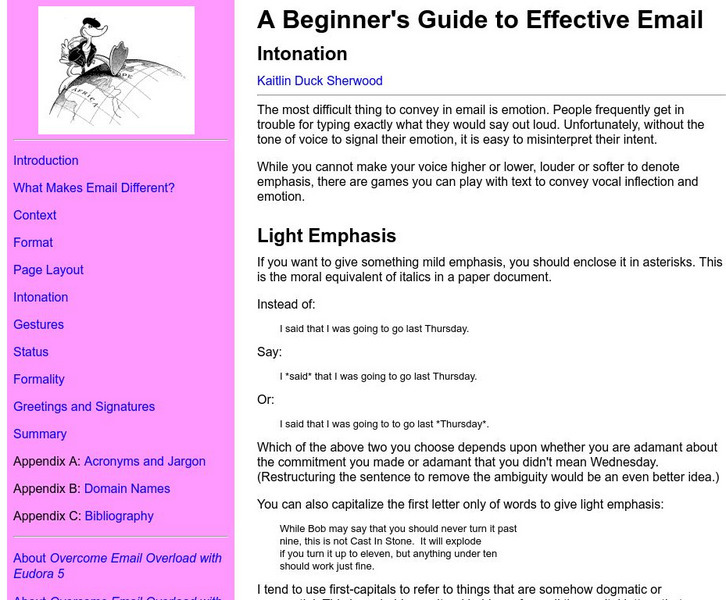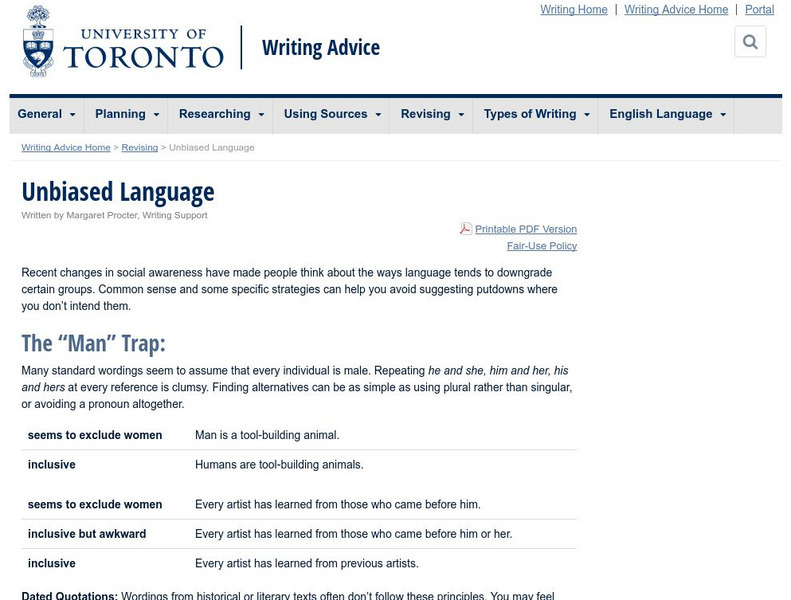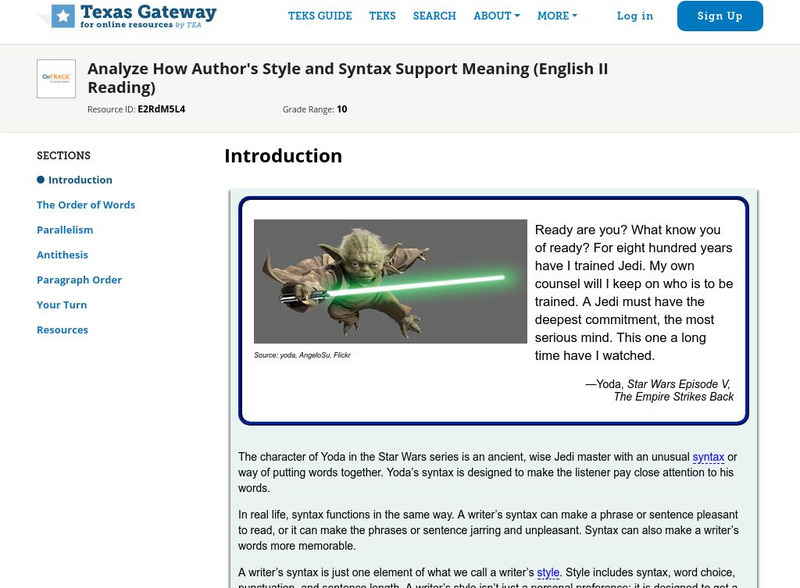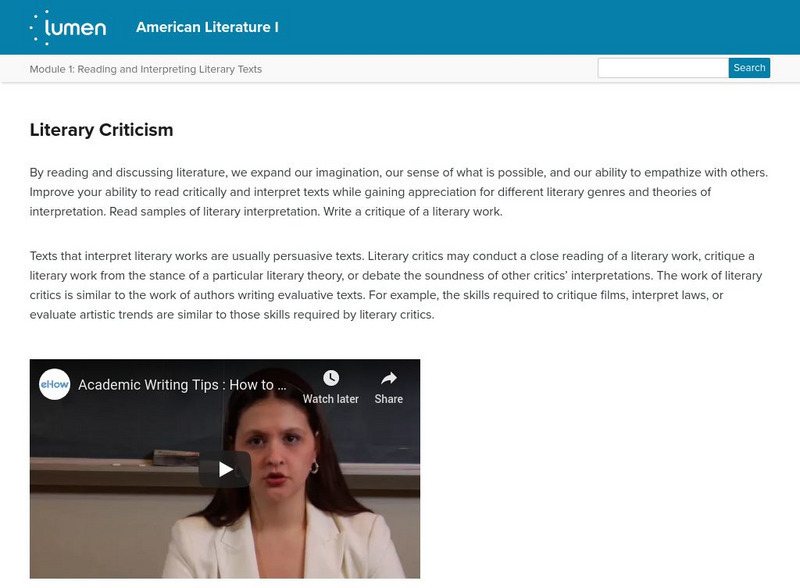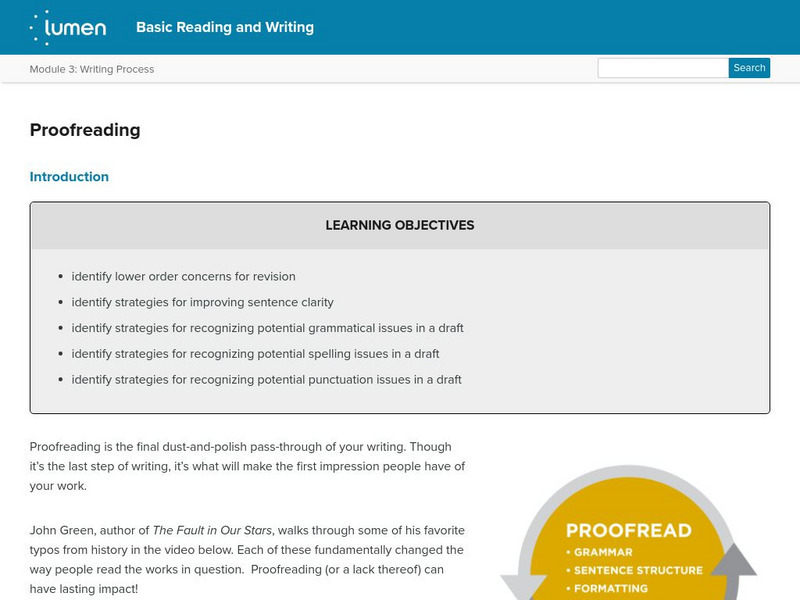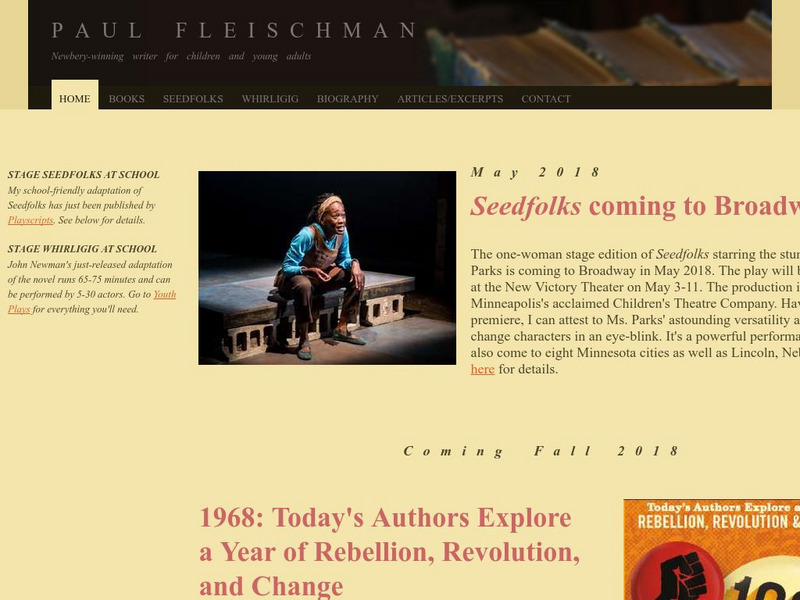Other
A Beginner's Guide to Effective Email: Intonation
A good site as a resource for changing tone and voice in the written medium of email. Discusses asterisks, capital letters, punctuation, whitespace, and lower-case letters.
Other
Literature Unit: "A Day No Pigs Would Die"
This site features questions for each of the chapters in Robert Newton Peck's "A Day No Pigs Would Die."
Northern Arizona University
Sojurn: Introduction to the Art of Fugue
An extremely comprehensive and detailed page on fugues, including audio clips and many illustrations. Gets very technical so a good background in music theory would be useful if you use this site.
ReadWriteThink
Read Write Think: Style Choices of Hemingway and Hawthorne
Lesson plan which helps students understand the impact of the literary element of style on a piece of writing. Students read and analyze the works of Ernest Hemingway and Nathaniel Hawthorne. L.11-12.3 Language Functions/Style,...
Other
Write Away: Finding Your Voice
This article, written by a college creative writing instructor, gives advice about developing a writer's voice. There are six sections with specific suggestions for improving your writing. While the source of this page is a site about...
Grammarly
Grammarly Handbook: Sentence Style
A list of three techniques used to develop sentence style: Sentence Variety, Sentence Emphasis, and Wordiness. Each technique links to more information.
Virtual Salt
Virtual Salt: A Glossary of Literary Terms
This site provides a long list of literary terms complete with full definitions and examples.
University of Illinois
University of Illinois Extension: Great Plant Escape: Flower Parts
Peruse this colorful site and discover the various part of a flower.
Varsity Tutors
Varsity Tutors: Web English Teacher: Paul Fleischman
Web English Teacher offers a group of resources for teaching and learning about author Paul Fleischman.
Grammarly
Grammarly Blog: How to Write Better Essays: 5 Concepts You Must Master
This blog article discusses essay writing including thesis development, strong form, style, conventions, and support and references.
University of Toronto (Canada)
University of Toronto: Unbiased Language
Resource acknowledges the changes in social awareness and how language is influenced by it. It presents suggestions as to how to avoid bias in writing. Some of the changes in terminology can have subtle differences in meaning. W.9-10.1d...
Sophia Learning
Sophia: Punctuation and Style
A nine-slide presentation discussing how to use punctuation to create or reflect the author's style. W.9-10.1d Style/tone/conv
Sophia Learning
Sophia: Asyndeton & Polysyndeton
A screencast lesson [4 mins, 28 secs] defining and providing examples of asyndeton and polysyndeton and discussing their purpose in sentences.
Robin L. Simmons
Grammar Bytes: The Item in a Series
This site is concerned with writing any kinds of items in a series. It verbally and graphically illustrates parallel structure, and shows how to punctuate a series.
Capital Community College Foundation
Guide to Grammar and Writing: Parallel Form
This site from the Capital Community College defines the term and gives many examples of faulty parallelism and the corrected version of sentences. Includes links to a couple of quizzes at the bottom of the page. "Most of the...
ReadWriteThink
Read Write Think: Defining and Exploring an Author's Stylistic Choices
Contains plans for two lessons that teach students how to recognize an author's use of style in literature. These plans use "Their Eyes Were Watching God" by Zora Neale Hurston as an example, but the basic ideas can be adapted to other...
Sophia Learning
Sophia: Sentence Length and Style
This slideshow lesson focuses on sentence length and style; it lists four types of sentences: fragments, short sentences, long sentences, and run-ons. It explains the effect that is achieved by using each of these sentence types for...
Texas Education Agency
Texas Gateway: Analyze How Author's Style and Syntax Support Meaning
Analyze how an author's style and syntax support meaning in a text. RI.9-10.3 author unfolds. CCSS.ELA-Literacy.CCRA.L.3
Texas Education Agency
Texas Gateway: Analyze How Author's Style and Syntax Support Meaning
Analyze how an author's style and syntax support meaning in a text. RI.9-10.3 author unfolds. CCSS.ELA-Literacy.CCRA.L.3
Lumen Learning
Lumen: Reading and Interpreting Literary Texts: Literary Criticism
This lesson focuses on how to write a literary criticism, the different theories and approaches to literary criticism, and their standard format.
Lumen Learning
Lumen: Writing Process: Proofreading
This lesson focuses on proofreading and editing including style, word choice, grammar, typos, tips for proofreading, proofreading strategies, and editing for language and sentence construction. It offers two videos: "5 Worst Typos of...
Lumen Learning
Lumen: Reading and Interpreting Literary Texts: How to Analyze a Short Story
This lesson focuses on analyzing a short story including all of the elements of a short story such as setting, plot and structure, and characterization.
Texas Education Agency
Texas Gateway: Polish Tone, Style, and Figurative Language (English Ii Writing)
In this lesson, students will learn strategies for evaluating and revising the tone, style, and figurative language in an essay.
Other
Paul Fleischman's Official Website
Have you ever wanted to know more about the life and work of Paul Fleischman? Use this site to learn more about this famous children's author.


